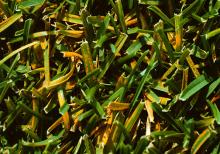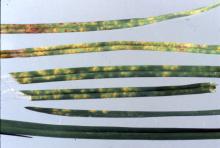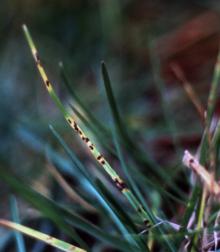Go to:
Hosts Rusts typically occur on bluegrasses, ryegrasses, and fine fescues.
Cause Several rust fungi including many species of Puccinia and Uromyces. The most prevalent turf rust fungi are Puccinia graminis (causes stem rust), P. striiformis (stripe rust), P. coronate (crown rust), and P. recondite and P. brachypodii (leaf rust). Rust diseases are more severe on slow-growing or stressed grasses. Shade, drought, poor nutrition, and incorrect mowing height are possible causes of stress. The fungi overwinter in diseased grass and can be spread by wind.
Symptoms Yellow specks on the leaf blades followed by development of yellow, orange, dark-orange-brown, or red rust pustules on either or both leaf surfaces. Infection may also be on stems and leaf sheaths. Severe rust infections can kill leaf blades and may cause the turfgrass to appear thin or weak. Weedy species can infest weakened turfgrass. Affected areas of the lawn may show a reddish, brown, or yellow tint.
Cultural control
- Fertilize and water to maintain rapid growth.
- Cut lawn frequently and remove clippings to reduce spread during active outbreaks.
- Plant rust-tolerant cultivars such as Rugby, Glade, Galaxy, Merion, A-34, Sydsport, and Baron. These cultivars are not completely resistant, so plant them in mixtures of two or more.
Chemical control Treat in early spring and fall when grass is growing slowly and the climate favors rust development. Note: Avoid using fungicides containing Group 1 fungicides (such as Cleary's 3336 or OHP 6672) on rust-affected lawns, because these products often aggravate rust diseases.
Products available in home packaging:
- BioAdvanced Fungus Control for Lawns at 32 fl oz/over 5,000 sq ft. Group 3 fungicide. H
- Spectracide Immunox Multi-Purpose Fungicide Spray Concentrate for Gardens at 7 fl oz/gal water over 500 sq ft. Group 3 fungicide. H
Products available for commercial use:
- Banner MAXX at 1 to 2 fl oz/1,000 sq ft. Group 3 fungicide. 12-hr reentry.
- Compass 50 WDG at 0.1 to 0.25 oz/1,000 sq ft. Do not use organosilicate additives. Group 11 fungicide. 12-hr reentry.
- Daconil Weather Stik at 4 to 5.5 fl oz/1,000 sq ft. For bluegrass only. Group M5 fungicide. 12-hr reentry.
- Disarm 480 SC at 0.18 to 0.36 fl oz/1,000 sq ft. Group 11 fungicide. 12-hr reentry.
- Eagle 20 EW at 1.2 fl oz/1,000 sq ft. May produce a growth regulation effect on Kentucky bluegrass. Group 3 fungicide. 24-hr reentry.
- Fame SC at 0.2 to 0.4 fl oz/1,000 sq ft. Group 11 fungicide. 12-hr reentry.
- Floxcor at 0.27 to 0.36 fl oz/1,000 sq ft plus an adjuvant. Group 11 fungicide. 12-hr reentry.
- Heritage at 0.2 to 0.4 oz/1,000 sq ft. Group 11 fungicide. 4-hr reentry.
- Insignia SC at 0.4 to 0.7 fl oz/1,000 sq ft. Do not use with organosilicate adjuvants. Group 11 fungicide. 12-hr reentry.
- Mancozeb 75% (Fore, Manzate, and Protect DF) at 4 oz/1,000 sq ft. Group M3 fungicide. 24-hr reentry.
- Mirage at 1 to 2 fl oz/1,000 sq ft. Group 3 fungicide. 12-hr reentry.
- Monsoon Turf at 0.6 fl oz/1,000 sq ft. Group 3 fungicide. 12-hr reentry.
- Pinpoint at 0.31 fl oz/1,000 sq ft. Apply to dry turf or after mowing. Group 11 fungicide. 12-hr reentry.
- PropiMax EC at 0.37 to 0.73 fl oz/1,000 sq ft. 12-hr reentry.
- Rayora at 0.7 to 1.4 fl oz/1,000 sq ft. Group 3 fungicide. Reentry after sprays have dried.
- Secure at 0.5 fl oz/1,000 sq ft. Group 29 fungicide. Reentry when sprays have dried.
- Spotrete F at 3.75 to 7.5 fl oz/1,000 sq ft. Group M3 fungicide. 24-hr reentry.
- Tebuzol 3.6F at 0.6 fl oz/1,000 sq ft. Group 3 fungicide. No reentry interval listed.
- Torque at 0.6 to 1.1 fl oz/1,000 sq ft. Do not mix with growth regulators during hot weather as injury may develop. Group 3 fungicide. 12-hr reentry.
- Tourney EZ at 0.37 oz/1,000 sq ft. Do not apply to Poa annua putting greens. Group 3 fungicide. 12-hr reentry.
- Velista at 0.3 to 0.5 oz/1,000 sq ft. Group 7 fungicide. 12-hr reentry.
Combination Fungicides
- Armada 50 WDG at 0.6 to 1.5 oz/1,000 sq ft. Do not use a silicone-based surfactant. Group 3 + 11 fungicide. 12-hr reentry.
- Briskway at 0.5 to 1.2 fl oz/1,000 sq ft. Can be used in hot weather. Group 3 + 11 fungicide. Reentry when sprays have dried.
- Concert at 4.5 to 8.3 fl oz/1,000 sq ft. Do not use on fine fescue turf. Group 3 + M5 fungicide. 12-hr reentry.
- Encartis at 3 to 4 fl oz/1,000 sq ft. Do not use with oil-based pesticides. Group 7 + M5 fungicide. Reentry when sprays have dried.
- Exteris Stressgard at 1.5 to 4 fl oz/1,000 sq ft. Group 7 + 11 fungicide. 12-hr reentry.
- Headway at 1.5 to 3 fl oz/1,000 sq ft. Do not use with silicone-based surfactants or EC formulations. Group 3 + 11 fungicide. 12-hr reentry.
- Heritage Action at 0.2 to 0.4 oz/1,000 sq ft. Group 11 + P1 fungicide. 12-hr reentry.
- Honor at 0.55 to 1.1 oz/1,000 sq ft. Do not use with organosilicone-based adjuvants. Group 7 + 11 fungicide. Golf course turf only.
- Interface at 3 to 5 fl oz/1,000 sq ft. Maintain agitation while spraying. Do not mix with adjuvants. Group 2 + 11 fungicide. 24-hr reentry.
- Lexicon at 0.34 to 0.47 fl oz/1,000 sq ft. Group 7 + 11 fungicide. 12-hr reentry.
- Navicon at 0.7 to 0.85 fl oz/1,000 sq ft. Group 3 + 11 fungicide. 12-hr reentry.
- Pillar G at 3 lb/1,000 sq ft. Group 3 + 11 fungicide. 12-hr reentry.
- Premion at 6 to 8 fl oz/1,000 sq ft. Group 3 +14 fungicide. Reentry when sprays have dried.
- Renown at 2.5 to 4.5 fl oz/1,000 sq ft. Group M5 + 11 fungicide. 12-hr reentry.
- Tartan at 1 to 2 fl oz/1,000 sq ft. Group 3 + 11 fungicide. 12-hr reentry.
References Smiley, R.W., Dernoeden, P.H., and Clarke, B.B. 2005. Compendium of Turfgrass Diseases. 3rd edition. St. Paul, MN: APS Press.
Beirn, L.A., Moy, M., Meyer, W.A., Clarke, B.B., and Crouch, J. 2011. Molecular analysis of turfgrass rusts reveals the widespread distribution of Puccinia coronata as a pathogen of Kentucky bluegrass in the United States. Plant Disease 95:1547-1557.





